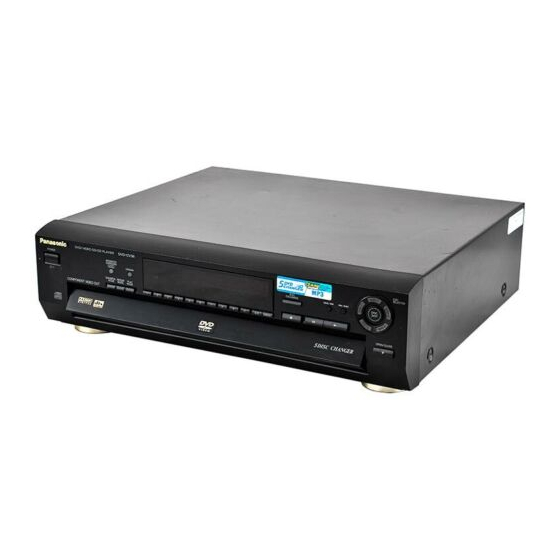Panasonic DVD-CV37 Manuel d'utilisation - Page 20
Parcourez en ligne ou téléchargez le pdf Manuel d'utilisation pour {nom_de_la_catégorie} Panasonic DVD-CV37. Panasonic DVD-CV37 24 pages. Dvd/cd player
Également pour Panasonic DVD-CV37 : Manuel d'utilisation (24 pages), Manuel d'utilisation (32 pages), Manuel d'utilisation (29 pages), Manuel rapide (2 pages), Manuel d'utilisation (24 pages)

Troubleshooting guide
Picture
Picture distorted.
No picture.
The picture shown on the
television is not normal.
(The sides of the picture are cut
off or black bands appear at the
top and bottom of the screen.)
Picture quality is poor.
Unit displays
"NoPLAY"
"CHECK"
"H∑∑"
∑∑ stands for a number.
Television displays
No on-screen display.
On-Screen Menu Icons not
displayed or only partially
displayed on the television.
The disc's menu is displayed in
a different language.
Glossary
Bitstream
This is the digital form of multiple channel audio data (e.g., 5.1 channel)
before it is decoded into its various channels.
Decoder
A decoder restores the coded audio signals on DVDs to normal. This is
called decoding.
Dolby Digital
This is a method of coding digital signals developed by Dolby Laboratories.
Apart from stereo (2-channel) audio, these signals can also be 5.1-channel
audio. A large amount of audio information can be recorded on one disc
using this method.
Dolby Pro Logic
A surround system where a 4-channel audio track is recorded as 2
channels and then is restored to 4 channels for play. The surround channel
is monaural and can reproduce up to 7 kHz.
DTS (Digital Theater Systems)
This surround system is used in many movie theaters around the world.
There is good separation between the channels, so realistic sound effects
are possible.
Dynamic range
Dynamic range is the difference between the lowest level of sound that can
be heard above the noise of the equipment and the highest level of sound
before distortion occurs.
20
≥Some distortion is normal during SEARCH.
≥Ensure that the equipment is connected properly.
≥Make sure the television is on.
≥Ensure the television's video input setting (e.g., VIDEO 1) is correct.
≥Go to the Video menu in the SETUP screen, and change "TV Aspect" to suit your television. You
may also need to change the screen mode on the television itself.
≥Ensure that the unit is connected directly to the television, and is not connected through a video
cassette recorder.
≥The 4:3 TV ZOOM function is on.
≥Check the settings in the On-Screen Menu Icons' Video menu.
≥You inserted a disc the unit cannot play; insert one it can.
≥Disc is dirty. Wipe the disc clean.
≥Trouble is likely to have occurred. The number following "H" depends on the status of the unit.
Reset procedure:
Press [POWER Í] to switch the unit to the standby mode and then back to ON. Alternatively,
press [POWER Í] to switch the unit to the standby mode, disconnect the AC power supply
cord, and then reconnect it.
≥If the service numbers fail to clear, note the service number and contact a qualified service person.
≥Go to Display in the SETUP menus, and select "On" for "On-Screen Messages".
≥Press [3, 4] while the rightmost icon is highlighted to move them down.
≥Go to Disc in the SETUP menus, and select the preferred language for "Menus".
Frame still and field still
Frames are the still pictures that go together to make a moving picture.
There are about 30 frames shown each second.
One frame is made up of two fields. A regular television shows these fields
one after the other to create frames.
A still is shown when you pause a moving picture. A frame still is made up
of two alternating fields, so the picture may appear blurred, but overall
quality is high. A field still is not blurred, but it has only half the information
of a frame still so picture quality is lower.
I/P/B
MPEG 2, the video compression standard adopted for use with DVD-
Video, codes frames using these 3 picture types.
I:
Intra coded picture (I-picture)
This is the standard picture and is a complete picture in itself. This
means it has the best picture quality and is the best to use when
adjusting the picture.
P: Predictive coded picture (P-picture)
This picture is calculated based on past I or P-pictures.
B: Bidirectionally-predictive coded picture (B-picture)
This picture is calculated by comparing past and future I and P-pictures
so it has the lowest volume of information.
Linear PCM (pulse code modulation)
These are uncompressed digital signals, similar to those found on CDs.
Playback control (PBC)
If a Video CD has playback control, you can select scenes and information
with menus (called menu play in these instructions).
Page
–
6
–
–
7, 16
–
15
15
5
–
–
–
16
14
16
